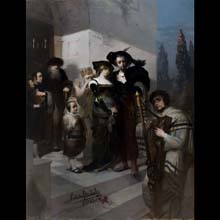
material: oil on canvas
dimensions: 250 × 192 cm
description: 19th-century painting contains a great many historical scenes which do not refer to specific events or show well-known figures. They form a painting genre which can be called the history-genre one. In such works, artists often referred to contemporary times, and if they illustrated remote history, the character and atmosphere of the past epoch were usually expressed through objects, clothes and, not infrequently, architecture. The title scene shows a young couple dressed in Renaissance clothes, standing on the stairs of the building, surrounded by some other people. They are of Jewish descent, which is indicated by their attire (a gabardine, the characteristic headgear – a fur cap), hairstyle (sidelocks) and the very type of the oriental looks. The whole group: a boy, an old man leaning on a young man and a young woman, bending forward and crying, are listening to the sound of the harp played by a man standing below. They are engrossed in the title "Song about the Destruction of Jerusalem", a melody expressing a longing for the lost land, for freedom. The young man is playing a sad story about the nation without the country, living far away from the Promised Land. One can also conclude that “the harp as a symbol of the worship of God, prophetic worship, a new song which brings God’s power to the earth, expresses hope for regaining independence. Worship always brings change, freedom and God’s rule on the Earth (2 Kings 3:15). The public saw some resemblance between the situation of the Jews and the fate of the oppressed Polish people during the Partitions. A melancholic tone, full of reverie and nostalgia, has been enhanced by subdued, almost monochromatic colours. Anna Budzałek
exposition: The Gallery of 19th Century Polish Art in Sukiennice,
The Cloth Hall, 1, Main Market Square
key: Around the academy >>>
dimensions: 250 × 192 cm
description: 19th-century painting contains a great many historical scenes which do not refer to specific events or show well-known figures. They form a painting genre which can be called the history-genre one. In such works, artists often referred to contemporary times, and if they illustrated remote history, the character and atmosphere of the past epoch were usually expressed through objects, clothes and, not infrequently, architecture. The title scene shows a young couple dressed in Renaissance clothes, standing on the stairs of the building, surrounded by some other people. They are of Jewish descent, which is indicated by their attire (a gabardine, the characteristic headgear – a fur cap), hairstyle (sidelocks) and the very type of the oriental looks. The whole group: a boy, an old man leaning on a young man and a young woman, bending forward and crying, are listening to the sound of the harp played by a man standing below. They are engrossed in the title "Song about the Destruction of Jerusalem", a melody expressing a longing for the lost land, for freedom. The young man is playing a sad story about the nation without the country, living far away from the Promised Land. One can also conclude that “the harp as a symbol of the worship of God, prophetic worship, a new song which brings God’s power to the earth, expresses hope for regaining independence. Worship always brings change, freedom and God’s rule on the Earth (2 Kings 3:15). The public saw some resemblance between the situation of the Jews and the fate of the oppressed Polish people during the Partitions. A melancholic tone, full of reverie and nostalgia, has been enhanced by subdued, almost monochromatic colours. Anna Budzałek
exposition: The Gallery of 19th Century Polish Art in Sukiennice,
The Cloth Hall, 1, Main Market Square
key: Around the academy >>>












